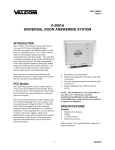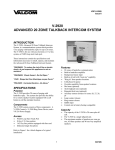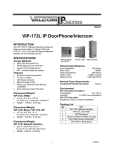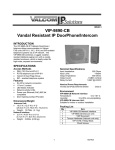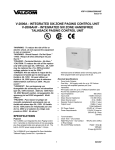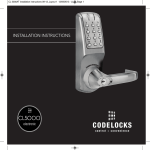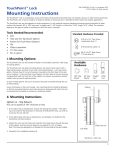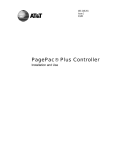Download Valcom V2904 Specifications
Transcript
Issue 7
V-2904
UNIVERSAL FOUR DOOR ANSWERING SYSTEM
INTRODUCTION
The V-2904, Universal Four Door Answering
System, when used with Valcom Door Plate
Speakers, provides voice paging with handsfree reply
to up to four doors from any telephone location. The
V-2904 initiates ring-in on the telephone system and
sends a confirmation tone to the door speaker. The
individual at the phone responding to the signal will
determine if access should be allowed. Pressing a
programmed code on the telephone dialpad or
pressing the remote button will unlock the door to
allow admission. The V-2904 also provides an alarm
control output to alert an unauthorized entry.
These instructions contain the specifications and
information necessary to install, operate and maintain
the Universal Four Door Answering System.
FCC Notice
Reorient the receiving antenna
Relocate the equipment with respect to the radio
or television
Move the equipment further away from the radio
or television
Plug the equipment into a different branch circuit
This equipment generates and uses radio frequency
energy and if not installed and used properly, that is,
in strict accordance with the instructions listed in this
User's Manual, may cause interference to radio and
television reception.
NOTE: The manufacturer is not responsible for
any radio or TV interference caused by
unauthorized modifications to this equipment.
Such modifications could void the user's authority
to operate the equipment.
It has been tested and found to comply with the limits
for a Class B Computing Device in accordance with
the specifications in Subpart B of Part 15 of the FCC
rules, which are designed to provide reasonable
protection against such interference in a residential
installation. If this equipment does cause interference
to radio or television reception, which can be
determined by turning off the equipment and seeing if
the interference stops, the user is encouraged to try
and correct the interference by one or more of the
following measures:
SPECIFICATIONS
Access
Electronic Key Systems
PABXs
1A2 Key Systems
Stand Alone Systems
Refer to Figure 1 for a simplified block diagram of a
typical installation.
1
947304
E-Key
C.O.Line
Position
Doorplate
Speaker
with
Pushbutton
V-2904
Universal
Four Door
Answering
System
Up to 4
Locations
Power
Supply
FIGURE 1 - SIMPLIFIED BLOCK DIAGRAM OF A TYPICAL INSTALLATION
Features
Compatible with PABX, E-Key and 1A2
telephone
Switch selectable - loop or ground start access
Provides handsfree talkback to four separate
locations
RJ11 modular connector for Tip and Ring
connections
Power ON LED
Provides contacts for up to four circuits
Programmable options:
Programming access code
Ring Pattern
Station Identification
Activate lock relay
Duration of lock relay activation
Time door can remain open after unlock
(exit delay time)
Entry delay time
Number of ring cycles
Disable station alarm
Alarm disable code
Station alert tone
Input for manual door unlock (push button)
Built-in 30Hz ring voltage generator with on/off
switch
Ringback tone to speaker
Calls can be placed On Hold
Call waiting
One-way all call with volume control
Background music input with volume control
Speaker to phone volume control
Phone to speaker volume control
Simultaneous calls placed in queue
Dial tone
Confirmation tone
Compatible with tone dial phones
Works with Valcom V-1072A doorplate speaker
or other Valcom one-way or talkback speakers.
Compatible with VPB-260 battery backup
Dimensions/Weight
Dimensions: 8.60" H x 11.00" W x 2.30" D
(21.84cm H x 27.94cm W x 5.84cm D)
Weight:
3.1 lbs. (1.41 kg)
Nominal Specifications
Input Impedance:
Input Level:
Output Impedance:
Ring Supply:
Suitable for REN of 5.0
600 Ohms
-10dBm Nominal
45 Ohms
90VAC, 30Hz
Power Requirements
Power Supply:
-24VDC filtered
600mA minimum
Environment
Temperature:
Humidity:
2
0 to 40°C
0 to 85% (non-precipitating)
any activity the phone is involved in will be
terminated and the phone will receive a momentary
warble tone, a station indication tone, the ringback
tone and be connected to the station with an open
door. After hangup, if the door is not closed, the
alarm condition will continue. If another
unauthorized entry is detected, it will override the
older one. When this new alarm condition is
resolved, the system will revert to the previous alarm
condition until all alarm conditions are resolved.
Components
The following equipment is recommended when
using the V-2904:
1 - V-2904 Universal Four Door Answering
System
1 - C. O. Line Position (Electronic Key
System); 1 - Loop Trunk Position (PABX) or 1 400 type line card (1A2 key)
1 - Dedicated single line phone*
1 to 4 Valcom Doorplate Speaker(s)**
1 - VP-624B Power Supply
When indication arrives that a door is open while
door station is inactive, such as a break-in, the system
waits the programmed period of time (entry delay
time) for a confirmation of entry indicating the
opening as legitimate. When this does not arrive in
the programmed time frame or if it arrives and the
door is not closed at the end of the programmed time
period, an alarm will sound in the same manner as
described above.
* A single line telephone cannot be connected to
both the V-2904 and an incoming central office
line.
** It is recommended that one talkback speaker
be used per door station. Use of more than one
talkback speaker per station may result in damage
to the V-2904. Up to 40 one-way amplified
speakers may be connected to a zone if the zone is
to be used as a one-way paging zone.
The V-2904 also provides a background music input
and is designed to automatically cut off at individual
stations during a page or during an alarm situation. If
background music is to be installed, a low level music
source such as the Valcom V-2952 FM Tuner will be
required.
DESIGN
The V-2904, Universal Four Door Answering System
was designed to provide voice paging with handsfree
reply to up to four door speakers from a telephone
location. The V-2904 initiates ring-in on the
telephone system and sends a confirmation tone to the
door when a button is pressed at the door (Valcom
doorplate speakers are normally used in this
application). The individual at the phone responding
to the signal can converse with the person at the door
and determine if access should be allowed. If the
door is equipped with an electric strikeplate, the
person at the phone can enter a programmed code on
the telephone dial pad or press a remote button to
unlock the door to allow admission. When the system
is in use and another call is placed from a different
station, the person on the telephone will hear a call
waiting tone corresponding to that door location.
(Example: Beep-Beep for Station 2). The call will
remain waiting for a programmed period of time. If
this additional call remains unanswered, it will drop
off after the programmed period of time for call
waiting.
Another feature of the V-2904 is the All Call Page.
By pressing the number "8" or "0" on the telephone
dialpad, the person at the phone can make a one-way
announcement to all stations. The All Call is also
overridden during an Alarm Condition.
INSTALLATION
Cabling
A 25 pair cable with a female amphenol connector
should be run from the V-2904 to a 66B-type
punchdown block. The cables should be terminated
on the connecting block in standard color code.
Refer to Figure 2 - Block Connections for the
suggested pinout locations.
Mounting
The V-2904 is designed to be wall or shelf mounted.
When wall mounting the V-2904, secure the unit to
wall studs or a suitable brace, away from heat sources
or strong magnetic fields (motors, fans, power
supplies, etc.) with controls and connectors
accessible. (A plywood backboard 2 feet square and
at least 1/2 inch thick attached to wall studs would be
considered a suitable brace).
Four #10 x ¾ inch flat-head wood screws are
included for mounting. Fasten two screws on the
mounting surface, allowing them to protrude 1/8 inch
to ¼ inch. Place the chassis of the V-2904 onto the
screwheads at the mounting slots.
The V-2904 provides an alarm control output for
unauthorized entry. When the door lock relay is
activated and the door remains open longer than the
programmed period of time, a ground potential will
appear on pin 3 of the V-2904 (unauthorized door
opening) that can be used to signal a customer
provided alarm, auto dialer, etc. Also, if the phone is
on hook, the phone will begin ringing in a pattern
designating which door failed to close. (Example:
Station 3 - ring-ring-ring). If the phone is off hook,
3
___ 6.
Position the remaining screws and fasten through the
remaining mounting slots. Tighten screws.
Connections
NOTE: The V-2904 could be used with equal
success at a doorway, gateway, window, secure
room or combination of these just to name a few
possible applications. The term station is used to
designate a location. Station 1 is used when
describing connections; all other stations would be
connected similarly. Refer to Figure 2 for pinouts
of the specific station location.
Connect the -24VDC power supply. 24VDC should be connected to pin 25 (S/V)
and Ground connected to pin 50 (V/S). The
power LED located on the V-2904 board
should illuminate.
Battery Backup
A Valcom VPB-260 Battery Backup may be added to
the system to provide power in case of power failure.
The VPB-260 plugs directly into the V-2904. Figure
4 shows the appropriate connection. The VPB-260
should be allowed to charge for approximately 9
hours before operating the V-2904. The Valcom
VPB-260 battery backup may be used as the sole
supply of power to the V-2904.
Mount a 66B-type punchdown block on the
backboard near the V-2904 Universal Four Door
Answering System and label the block per Figure 2.
Remote Door Unlock Relay
Move slide switch SW2 on the V-2904 to the
appropriate location, Loop or Ground Start, (see
Figure 3) depending on how the V-2904 is accessed.
Figure 6 shows the V-2904 contact arrangement
available for electric strike plate operation.
Before connecting an electric lock to the V-2904,
consult the manufacturer instructions for the proper
connecting arrangement.
If a modular cord is used for Tip and Ring
connections, start at step ONE. For 66 block
connections start at step TWO.
___ 1.
___ 2.
Connect Tip of the key system line position,
loop or ground start trunk, to Pin 26 (W/BL)
and Ring to Pin 1 (BL/W).
___ 3.
Connect Tip of Zone 1 45 Ohms talkback
speaker to pin 32 (R/O) and Ring to pin 7
(O/R).
___ 4.
If using a door button with the Zone 1
talkback speaker, connect normally open,
single pole push button switch to Door
Button 1 connection pin 33 (R/G) and pin 9
(BR/R) Ground. (Figure 5 depicts a typical
speaker/door button hookup).
___ 5.
Remote Push Button
for Manual Door Release
Connect one end of the modular cord to the
V-2904 RJ11 and the other end to the
appropriate line position of the phone
system. Go to step 3.
A momentary, normally open, single-pole,
single-throw switch can be connected to the system.
Suggested pinouts to the 66B-type block are shown in
Figure 7. Again, refer to manufacturer instructions
for proper connections. The remote button should be
placed in an inconspicuous location to provide a more
secure system.
NOTE: If the remote button does not respond,
you have most likely entered a confirmation press.
Additional presses will result in an alarm
condition.
Handsfree Indicator ("Station
Outputs")
The V-2904 supplies connections to allow handsfree
indicators to be connected to the system. No
indication is available during All Call. During
handsfree communication, with station 1, pin 6 goes
to -24VDC when connected as shown in Figure 8.
Maximum current available is 50mA. Other station
outputs react in a similar manner.
Move slide switch SW1 (located on the
V-2904 board) to the ON position if the
telephone system is to ring when the door
button is pressed. (Refer to Figure 3 for
location).
4
FIGURE 2 - BLOCK CONNECTIONS
Tip
Ring
Common Audible Make
Common Audible Stationary
Common Audible Break
Unauthorized Door Opening
Background Music Tip
Background Music Ring
Door 1 Unlock Make
Door 1 Unlock Stationary
Door 1 Unlock Break
Station 1
Handsfree Speaker 1 Tip
Handsfree Speaker 1 Ring
Door Button 1
Remote 1
Door Sensor 1
Ground 1
Door 2 Unlock Make
Door 2 Unlock Stationary
Door 2 Unlock Break
Station 2
Handsfree Speaker 2 Tip
Handsfree Speaker 2 Ring
Door Button 2
Remote 2
Door Sensor 2
Ground 2
Door 3 Unlock Make
Door 3 Unlock Stationary
Door 3 Unlock Break
Station 3
Handsfree Speaker 3 Tip
Handsfree Speaker 3 Ring
Door Button 3
Remote 3
Door Sensor 3
Ground 3
Door 4 Unlock Make
Door 4 Unlock Stationary
Door 4 Unlock Break
Station 4
Handsfree Speaker 4 Tip
Handsfree Speaker 4 Ring
Door Button 4
Remote 4
Door Sensor 4
Ground 4
Power Supply GND
Power Supply -24VDC
5
W/BL
BL/W
W/O
O/W
W/GR
GR/W
W/BR
BR/W
W/S
S/W
R/BL
BL/R
R/O
O/R
R/G
G/R
R/BR
BR/R
R/S
S/R
BK/BL
BL/BK
BK/O
O/BK
BK/G
G/BK
BK/BR
BR/BK
BK/S
S/BK
Y/BL
BL/Y
Y/O
O/Y
Y/G
G/Y
Y/BR
BR/Y
Y/S
S/Y
V/BL
BL/V
V/O
O/V
V/G
G/V
V/BR
BR/V
V/S
S/V
26
1
27
2
28
3
29
4
30
5
31
6
32
7
33
8
34
9
35
10
36
11
37
12
38
13
39
14
40
15
41
16
42
17
43
18
44
19
45
20
46
21
47
22
48
23
49
24
50
25
Figure 3 - Connector and Control Locations
Music
Phone to Speaker
All Call
Handsfree
Volume
Controls
Gnd Start
SW2
Loop Start
Speaker to Phone
Amphenol Connector
Off
On
Ringer
SW1
RJ11
Power LED
Figure 4 - Battery Backup
V-2904
VPB-260
TYPICAL APPLICATIONS
Figure 5 - Doorplate Speaker with Pushbutton
66 Block
Handsfree Speaker 1 Tip
Handsfree Speaker 1 Ring
Door Button 1
Ground 1
V-1072A
(R/O)
(O/R)
(R/G)
(BR/R)
P 32
P 7
P 33
P 9
T
R
Handsfree Talkback
45 Ohm Speaker
with Pushbutton
PB
Figure 6 - Remote Door Unlock Relay
Customer Provided
Equipment
NOTE: Consult manNO
Electric
facturer's connection
Com
Strikeplate
diagram for connection
of strikeplate. N. C.
NC
Solenoid
connection may be
required on some
strikeplates instead of
N.O.
Strikeplate
66 Block
Door 1 Unlock Make
Door 1 Unlock Stationary
Door 1 Unlock Break
(W/S)
(S/W)
(R/BL)
P 30
P 5
P 31
NO = Normally Open
NC = Normally Closed
Power Supply
6
TYPICAL APPLICATIONS (Continued)
Figure 7 - Remote/Confirmation Pushbutton for Manual Door Release
Customer Provided
Equipment
66 Block
Remote 1
(G/R)
P8
Ground 1
(BR/R)
P9
Momentary
Single Pole, N. O.
Single Throw
Switch
Figure 8 - Handsfree Indicator
Customer Provided
Equipment
66 Block
Station 1
(BL/R)
P6
-
Ground 1
(BR/R)
P9
+
Figure 9 - Door Sensor
Customer Provided
Equipment
66 Block
Door Sensor 1
(R/BR)
P34
Ground 1
(BR/R)
P9
Magnetic Door
Switch
Figure 10 - Unauthorized Door Opening
Customer Provided
Equipment
66 Block
Unauthorized Door Opening
50mA, -24VDC
current maximum
available for
indicator
Indicator
Signal Out
(GR/W) P 3
Alarm
-24VDC
To Alarm, auto dialer, etc.
-24VDC, 125mA max
* Signal out only, will not drive alarm directly
** Ground must be common
Customer provided low current relay
Figure 11 - Remote Signalling Relay
Customer Provided
Equipment
66 Block
Common Audible Make
Common Audible Stationary
Common Audible Break
(W/O)
P27
(O/W)
P 2
(W/GR) P28
NO = Normally Open
NC = Normally Closed
Relay contacts rated at 1A –24VDC
NO
Com
NC
Bells, buzzers, etc.
Alerting Device
Power Supply
7
The V-2904 is designed to allow the user to program
its functions to meet the requirements of the specific
application. The V-2904 is, however, shipped from
the factory with all functions pre-set to default
settings. These default settings are listed in the
Program Chart.
Door Sensor
When this contact is shorted (by opening the door,
gate, etc.) without a legitimate dialpad or remote key
press opening, this will initiate an alarm condition.
Refer to Figure 9 for typical connections.
Unauthorized Door Opening
It is strongly recommended that the default
settings be changed to suit the needs of the
situation. The settings of the Access Code and
Door Unlock Code, particularly, should be
changed to provide a more secure system.
During an alarm state, UDO (unauthorized door
opening) goes to ground, to signal a customer
provided alarm that an alarm condition exists. Refer
to Figure 10 for typical connections.
Remote Signaling (Alerting Device)
The following instructions explain the procedures
required to program the codes for the V-2904.
Individual codes can be programmed per feature for
each station or per feature for the total system. After
each program change, a dial tone will be received
designating a proper entry.
The V-2904 supplies contacts to allow an alerting
device to be connected to the system. These contacts
follow the ringing cycle and can be used to operate a
remote signaling device such as a bell, buzzer or
light. One device provides alert indication for the
entire system. Refer to Figure 11 for a typical
connection using these contacts.
Master Access Code
The Master Access Code allows entry to
programming as well as to the use of the system. It is
essential that this code remain confidential to
maintain the security of the system. The Access
Code can be 1 to 7 digits in length. The asterisk (*)
or number (#) signs can not be used in the access
code.
Background Music Connections
Connect the low level (-10dBm nominal) output of a
music source to pin 29 (W/BR) and pin 4 (BR/W) of
the 66 block. Adjust input of the music source to a
minimum. Volume of the background music will be
regulated by the volume control of the V-2904.
Volume Adjustments
The default master access code is 1 2 3. To change
this code:
1. Lift handset and hear dial tone.
2. Press # # # on the dial pad.
3. Enter the old access code on the dial pad.
4. Press * * * on the dial pad.
5. Enter the new access code on the dial pad.
6. Press * * * again.
7. Will receive dial tone if programmed correctly.
There are four volume controls on the V-2904. See
Figure 3 for location of these controls.
___ 1.
Phone to Speaker: Adjusts speaker volume.
___ 2.
Speaker to Phone: Adjusts talkback volume
from the speaker. IMPORTANT: Set this
volume at the lowest practical level.
Setting this control too high will increase
background noise without giving greater
talkback volume.
___ 3.
All Call: Adjusts volume of all call
announcements at the doorplate speaker.
___ 4.
Music: Adjusts Background Music volume
at the door speaker.
Programming Functions
The following program instructions show the
access code for each function as 1 2 3. If a new
master access code is programmed prior to
programming the following functions, the new
access code would be substituted where the 1 2 3 is
shown.
These following codes cannot contain # as part of
their code.
PROGRAMMING
General
Ring Pattern
NOTE: The V-2904 can be accessed via tone
dial systems and programming must be
performed with a tone dial set.
When the doorplate button at a station is pressed, the
V-2904 initiates ring-in on the telephone system.
There are three ring patterns available.
8
Activate Lock Relay (Door Unlock)
2 seconds on, 4 seconds off (American ring)
2 bursts in 2 seconds, 2 seconds off (British ring)
1 second on, 4 seconds off (Dutch ring)
This code would be used to operate the door unlock
contacts which can be used to open an electric lock
used at a doorway or gate. The default access code to
activate the lock relay is *. This code can be from 1
to 7 digits and the asterisk (*) sign can be
programmed in this code if desired.
To change this code:
1. Lift handset and hear dial tone.
2. Press # 1 2 3 # on the dial pad.
3. Enter station number (1-4) or * for all stations.
4. Enter up to 7 digits.
5. Press #.
6. Receive dial tone.
To change the ring pattern:
American Ring (default)
1. Lift handset and hear dial tone.
2. Press # 1 2 3 * 5 on the dial pad.
3. Press #, receive dial tone.
British Ring
1. Lift handset and hear dial tone.
2. Press # 1 2 3 * 6 on the dial pad.
3. Press #, receive dial tone.
Duration of Lock Relay Activation
Dutch Ring
1. Lift handset and hear dial tone.
2. Press # 1 2 3 * # on the dial pad.
3. Press #, receive dial tone.
This function determines the length of time the lock
relay remains activated after dialing the door unlock
code. The default equals 2 seconds. The length of
time the lock relay remains activated can be from 1 to
99 seconds depending on the specific situation.
However, once an opening and closing of a door
takes place, the unlock relay will release prior to the
expiration of the programmed period preventing
further entries.
To change this default setting:
1. Lift handset and hear dial tone.
2. Press # 1 2 3 # 6 on the dial pad.
3. Enter station number (1-4) or * for all stations.
4. Enter the number of seconds the lock should
remain activated (1-99).
5. Press #.
6. Receive dial tone.
NOTE: The common audible relay contacts
follow the ringing cadence with the exception
of British Ring. In British Ring mode, the
contacts close at the beginning of the first
burst and remain closed until the end of the
second burst.
Station Identification
When a door button is pressed, it activates the phone
to ring. When the phone is answered, ringing is
removed and the phone may or may not receive a
station identification tone (depending on how
programmed).
Time Door May Remain Open after
Unlock before Alert (this period of time also
Station ID Tone Always Generated (default)
1. Lift handset and hear dial tone.
2. Press # 1 2 3 * 7 on the dial pad.
3. Press #, receive dial tone.
sets the exit delay time)
The length of time the door or gate should remain
open will vary depending on the actual application.
A drive-through gate may require a longer time than a
walk-through door. If, for some reason, the opening
does not close by the designated period of time, an
alarm condition will occur (see Operation). The
possible programmed time for a door to remain open
can be from 0 to 999 seconds. The default for this
function is 15 seconds. This default is changed by:
1. Lift handset and hear dial tone.
2. Press # 1 2 3 # 7 on the dial pad.
3. Enter station number (1-4) or * for all stations.
4. Enter the number of seconds the door should
remain open (0-999).
5. Press #.
6. Hear dial tone.
Station ID Tone Generated when Station in
Alarm Condition
1. Lift handset and hear dial tone.
2. Press # 1 2 3 * 8 on the dial pad.
3. Press #, receive dial tone.
Station ID Tone Generated for Calls from Non
Alarm Stations only
1. Lift handset and hear dial tone.
2. Press # 1 2 3 * 9 on the dial pad.
3. Press #, receive dial tone.
Station ID Tone Never Generated
1. Lift handset and hear dial tone.
2. Press # 1 2 3 * 0 on the dial pad.
3. Press #, receive dial tone.
9
NOTE: When a disabled station is accessed, the
alert tone will be at a lower tone as a reminder
that the alarm at that station has been disabled.
Entry Delay Time
If a key entry occurs at a door (an entry not using the
dialpad or remote button) the remote button must be
pressed or the confirmation code must be dialed on
the telephone keypad. This must be done within a
designated period of time after the door is opened
signifying a legitimate door opening or an alert will
sound. The default time for the confirmation press is
15 seconds. This time can be changed by:
1. Lift handset and hear dial tone.
2. Press # 1 2 3 # 8.
3. Enter station number (1-4) or * for all stations.
4. Enter time length in seconds (0-999).
5. Press #.
6. Receive dial tone.
To enable a door alarm that has been disabled:
1. Lift handset and receive dial tone.
2. Press 6.
3. Press station number (1-4) or * for all stations.
4. Receive dial tone.
Alert Tone
The phone and station receives a ringback tone prior
to connection. Default - the station receives the tone.
To remove the alert tone:
1. Lift handset and receive dial tone.
2. Press # 1 2 3 # 9.
3. Enter station number (1-4) or * for all stations.
4. Press 0.
5. Press #.
6. Receive dial tone.
To re-activate the alert tone:
1. Lift handset and receive dial tone.
2. Press # 1 2 3 # 9.
3. Enter station number (1-4) or * for all stations.
4. Press 1.
5. Press #.
6. Receive dial tone.
Duration of Ringing
When a door button is pressed, it activates the phone
into a ring cycle. The ring cycle will continue for a
programmed time period and stop if unanswered.
The default equals approximately 30 seconds. To
change this default:
1. Lift handset and receive dial tone.
2. Press # 1 2 3 # 5.
3. Enter station number (1-4) or * for all stations.
4. Enter ringing duration (1-255 seconds)
(0 = no time out)
5. Press #.
6. Receive dial tone.
Door Detect
Some door alarm contacts are closed when the door is
closed and some are open when the door is closed.
By default, the V-2904 uses door alarm contacts that
are open when the door is closed.
To change this default:
1. Lift handset and receive dial tone.
2. Press # 1 2 3 # 0 1.
3. Press # and receive dial tone.
Disable Station Alarm
On power up, the station alarm condition is active. In
the event a doorway or gate would need to be left
open for an extended time (or at least longer than the
programmed time it can remain open before an alarm
condition), the alarm can be disabled.
OPERATION
To leave door open without causing an alarm
condition:
1. Lift handset and receive dial tone.
2. Press 5.
3. Press station number (1-4) to be disabled or *
for all stations.
4. Enter disable code (default is *; this may have
been changed).
5. Receive dial tone.
When the doorplate button at a station is pressed,
interrupted ring voltage from the V-2904 initiates
ring-in on the telephone system and sends a
confirmation tone to the door. When the phone is
answered, a series of optional tones may be heard in
the receiver. These tones numerically indicate which
door is calling. These are followed by a ringback
tone and connection to the handsfree speaker. When
the phone is busy with one station and a call is placed
from another station, the person on the telephone will
hear a call waiting tone corresponding to the door
location. (Example: Station 2 - Beep-Beep).
Repeated button presses from the station will cause
repeated signals to the phone provided the presses are
separated by 5 seconds. If the 2nd call is not
answered during the programmed time (determined
by the programmed number of ring cycles) after the
last press, it will lose its power to be answered.
If the door is equipped with an electric strikeplate, a
The default code for disabling the station alarm
condition is *. To change this default:
1. Lift handset and hear dial tone.
2. Press # 1 2 3 *.
3. Enter station number (1-4) or * for all stations.
4. Enter up to 7 digits.
5. Press #.
6. Receive dial tone.
10
code can be dialed from the phone to operate the
relay to unlock the door. The lock relay will remain
open for a programmed period of time. A normally
open, single-pole push button switch can also be
connected to the V-2904 to manually operate the door
unlock relay. The lock relay will remain open as long
as the remote button is held (maximum 99 seconds)
plus the programmed period of time.
be received as tones designating the station number
trying to call in (example: Station 2 - beep, beep).
Repeated door button presses from that station will
cause repeated indications to the phone provided the
presses are separated by 5 seconds. If the second call
is not answered within the programmed number of
ring cycles, the call waiting condition will time out.
To answer call waiting, first receive dial tone by
pressing # or placing active station "on hold" (see
"Station On Hold" Section). Then dial station
corresponding to location of call waiting indication.
Another way of answering call waiting is to go "on
hook" with phone and let the call ring in.
If the door remains open longer than the programmed
time after the lock relay has closed and a customer
supplied door sensor is provided, an alarm condition
will occur. If on hook, the phone will begin ringing
in a pattern indicating which door failed to close.
When answered, the phone will receive a momentary
warble tone, tones indicating location, the ringback
indication and be connected to the station. If off
hook, any activity the phone is involved in will cease
and the phone will receive the same sequence of
tones as mentioned previously and be connected to
the station. After hang up, in both instances, if the
door is not closed, the alarm condition will continue.
If another unauthorized entry is detected, it will
override the older one. When this new alarm
condition is resolved, the system will revert to the
previous alarm condition until all alarm conditions
are resolved.
NOTE: The call waiting duration corresponds to
the number of ring cycles generated when the door
button is pressed (see Section titled "Duration of
Ringing" page 10).
Exiting without Alarm Activation
1. Lift handset and receive dial tone.
2. Dial station to be used for exit and enter unlock
code or press manual door unlock push button for
desired station.
3. Exit door of station within the programmed
exit delay time.
When an indication arrives that a door is open while
the door station is inactive, (example: a break-in) the
system waits the programmed period of time for a
confirmation of entry, if the confirmation of entry is
not received, the unauthorized entry alert will take
place as described previously.
Call Out from the Phone
The single line telephone, C. O. line position, loop or
ground start trunk used with the V-2904 is dedicated
to the communications and to features accessed
within the V-2904 system. The phone can be used to
access individual stations by pressing the number
corresponding to the desired station. (example: 1 for
door 1, 2 for door 2, etc.). A ringback tone (optional)
will be generated prior to connection to a station.
Pressing the number "8" or "0" on the telephone
dialpad, a person at the phone can make a one-way
announcement to all stations. A ringback tone is
received in the handset preceding connection to the
all call circuit.
Confirmation of Entry
When a key entry is made (an entry not using the
dialpad or remote button), either the remote button
must be pressed (a confirmation press) within the
programmed period of time after the door is opened
or the telephone can be used to dial the appropriate
confirmation of entry. To confirm an entry by phone:
1. Lift handset and receive dial tone.
2. Enter the door number and appropriate door
unlock code.
A confirmation press or entering the unlock code via
telephone to signify a legitimate door opening must
take place before the programmed period of time ends
or an alarm condition will occur.
A telephone connection to a station can be terminated
by hanging up or flashing the switchhook. Dial tone
returns after each of these actions.
All Call "Meet Me"
A single press at a station during an all call page will
terminate the all call and connect the phone to the
station where the press occurred. While the phone is
talking to this station via the "Meet Me" page, two
presses (within one second of each other from another
station) will end the original "Meet Me" connection
and send the phone to the new station in a "Meet Me"
page.
NOTE: The remote button can be used for a
confirmation press or to activate the lock relay
(door unlock).
Call Waiting
If the phone is connected to station 1 in a
conversation and station 2 attempts, by pressing the
door button, to call in, the individual at the phone will
receive a call waiting indication. The indication will
Station On Hold
Calls can be placed on hold by pressing the
11
switchhook. This press should be a flash of less than
one second. Holding the switchhook down for a
longer period will disconnect the call.
Call (540) 563-2000 and press 1 for Technical
Support or visit our website at
http://www.valcom.com.
TECHNICAL ASSISTANCE
VALCOM equipment is not field repairable.
VALCOM maintains service facilities in Roanoke,
VA. Should repairs be necessary, attach a tag to the
unit clearly stating your company name, address,
phone number, contact person and the nature of the
problem. Send the unit to:
Valcom, Inc.
Repair and Return Dept.
5614 Hollins Road
Roanoke, VA 24019-5056
When trouble is reported, make certain there are no
broken connections leading to this system. Table 1
identifies some possible problems with solutions.
Assistance in troubleshooting is available from the
factory. When calling, you should have a VOM and
a telephone test set available and call from the job
site.
USER GUIDE
FUNCTIONS
ACTIONS
Call a Station
Dial Station Number (1-4).
Unlock Door
Dial Station Number then dial unlock code (or press remote push button).
All Call
Dial 8 or 0.
Disable Alarm
Dial 5, then station number to be disabled or * for all stations, then dial alarm
disable code.
Enable Alarm
Dial 6, then station number to be enabled or * for all stations.
Exiting with Alarm On
Access station used for exit then dial unlock code (or press remote push
button), then exit door within exit delay time.
Entering with Alarm On
Enter door, then dial the station number of door entered and the appropriate
door unlock code (or press door's remote push button) within entry delay
time.
12
TABLE 1 - TROUBLESHOOTING CHART
PROBLEMS
ACTIONS
No system operation; Power LED not lit.
Verify power from power supply.
No system operation; power LED is lit.
Verify that 25 pair connector is completely
plugged into circuit board connector.
Verify all connections.
No paging at speaker.
Check doorplate speaker connections.
Adjust Phone to Speaker volume.
Paging at speaker but no reply from speaker.
Adjust Speaker to Phone volume.
No system ringing when doorplate button
pressed.
Check Ring "ON/OFF" switch.
Door unlock relay does not operate.
Check connections at block.
Verify proper access code.
Door strike does not operate.
Do you have a power supply for your door strike?
(See Figure 6).
VALCOM LIMITED WARRANTY
Valcom, Inc. warrants its products only to the original purchaser, for its own use, to be free from defects in materials and workmanship under conditions of
normal use and service for a period of one year from the date of shipment. This Limited Warranty obligation shall be limited to the replacement, repair or
refund of any such defective device within the warranty period, provided that:
1. inspection by Valcom, Inc. indicates the validity of the claim;
2. the defect is not the result of damage, misuse or negligence after the original shipment;
3. the product has not been altered in any way or repaired by others and that factory sealed units are unopened (a service charge plus parts
and labor will be applied to units defaced or physically damaged);
4. freight charges for the return of products to Valcom are prepaid;
5. all units 'out of warranty' are subject to a service charge. The service charge will cover minor repairs (major repairs will be subject to
additional charges for parts and labor).
This Limited Warranty is in lieu of and excludes all other warranties, expressed or implied and in no event shall Valcom, Inc. be liable for any
anticipated profits, consequential damages, loss of time or other losses incurred by the buyer in connection with the purchase, operation,
maintenance, installation, removal or use of the product. The maximum liability of Valcom under this warranty is limited to the purchase price of the
specific Product covered by the warranty.
Disclaimer. Except for the Limited Warranty provided herein, the product is provided “as-is” without any warranty of any kind whatsoever including, without
limitation, any WARRANTY OF MERCHANTABILITY, FITNESS FOR A PARTICULAR PURPOSE OR NON-INFRINGEMENT.
This warranty specifically excludes damage incurred in shipment. In the event a product is received in damaged condition, the carrier should be notified
immediately. Claims for such damage should be filed with the carrier involved in accordance with the F.O.B. point.
Headquarters:
Valcom, Inc.
5614 Hollins Road Roanoke, VA 24019-5056
Phone: (540) 563-2000 FAX: (540) 362-9800
13
PROGRAM CHART - RECORD AND FILE IN A SECURE PLACE
Function
Master Access Code (MAC)
Ring Pattern
American Ring
British Ring
Dutch Ring
Station Identification
ID beeps always generated
ID beeps when alarm condition
ID beeps non-alarm condition
No ID Beeps
Default
Reprogram
Parameter
123
# # # 1 2 3 * * * ______ * * *
7 digits excluding
# and *
American
Ring
# MAC * 5
# MAC * 6
# MAC * #
ID beeps
always
generated
New Program
# MAC * 7
# MAC * 8
# MAC * 9
# MAC * 0
Activate Lock Relay
Sta 1
Sta 2
Sta 3
Sta 4
*
*
*
*
Sta 1 # MAC #1 _________ #
Sta 2 # MAC #2 _________ #
Sta 3 # MAC #3 _________ #
Sta 4 # MAC #4 _________ #
All Doors # MAC #* ______#
7 digits including *
Sta 1
Sta 2
Sta 3
Sta 4
Duration of Lock
Relay Activation
Sta 1
Sta 2
Sta 3
Sta 4
2 sec
2 sec
2 sec
2 sec
Sta 1 # MAC #61________ #
Sta 2 # MAC #62________ #
Sta 3 # MAC #63________ #
Sta 4 # MAC #64________ #
All Doors # MAC #6*_____#
1-99 in seconds
Sta 1
Sta 2
Sta 3
Sta 4
Time Door May
Remain Open After
Unlock Before Alert
(Exit Delay Time)
Sta 1
Sta 2
Sta 3
Sta 4
15 sec
15 sec
15 sec
15 sec
Sta 1 # MAC #71________ #
Sta 2 # MAC #72________ #
Sta 3 # MAC #73________ #
Sta 4 # MAC #74________ #
All Doors # MAC #7*_____#
0-999 in seconds
Sta 1
Sta 2
Sta 3
Sta 4
Sta 1
15 sec
15 sec
15 sec
15 sec
Sta 1 # MAC #81________ #
Sta 2 # MAC #82________ #
Sta 3 # MAC #83________ #
Sta 4 # MAC #84________ #
All Doors # MAC #8*_____#
0-999 in seconds
Sta 1
Sta 2
Sta 3
Sta 4
30 sec
30 sec
30 sec
30 sec
Sta 1 # MAC #51________ #
Sta 2 # MAC #52________ #
Sta 3 # MAC #53________ #
Sta 4 # MAC #54________ #
All Doors # MAC #5*_____#
1-255 sec
0 = no time out
Sta 1
Sta 2
Sta 3
Sta 4
*
*
*
*
Sta 1 # MAC *1________ #
Sta 2 # MAC *2________ #
Sta 3 # MAC *3________ #
Sta 4 # MAC *4________ #
All Doors # MAC **_____#
7 Digits
Sta 1
Sta 2
Sta 3
Sta 4
OFF or ON
Sta 1
Sta 2
Sta 3
Sta 4
Entry Delay Time
Sta 2
Sta 3
Sta 4
Duration of Ringing
Sta 1
Sta 2
Sta 3
Sta 4
Alarm Disable Code
Sta 1
Sta 2
Sta 3
Sta 4
Alert Tone
Sta 1
Sta 2
Sta 3
Sta 4
ON
ON
ON
ON
Sta 1 On
Sta 2 On
Sta 3 On
Sta 4 On
# MAC # 911 #
# MAC # 921 #
# MAC # 931 #
# MAC # 941 #
Sta 1 Off
Sta 2 Off
Sta 3 Off
Sta 4 Off
# MAC # 910 #
# MAC # 920 #
# MAC # 930 #
# MAC # 940 #
All Doors Off # MAC #9*0#
All Doors On # MAC #9*1#
Door Detect Default
Sta 1 # MAC # 010
Sta 2 # MAC # 020
Sta 3 # MAC # 030
Sta 4 # MAC # 040
Door contact open
when door is closed.
Door Detect Reversed
Sta 1 # MAC # 011
Sta 2 # MAC # 021
Sta 3 # MAC # 031
Sta 4 # MAC # 041
Door contact closed
when door is closed.
INSTALLATION
____________________________________________________________________________
INSTALLING COMPANY
___________________________________________________________________
INSTALLER
___________________________________________
DATE
______________________
A proper programming sequence is followed by a dial tone - An improper programming sequence by a busy tone.
14














